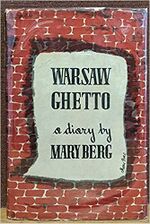Difference between revisions of "File:1946 Berg it.jpg"
| Line 2: | Line 2: | ||
{it} [[Mary Berg]]. ''Il ghetto di Varsavia''. Roma [Italy]: De Carlo, 1946. | {it} [[Mary Berg]]. ''Il ghetto di Varsavia''. Roma [Italy]: De Carlo, 1946. | ||
* See [[Mary Berg / Miriam Wattenberg (F / Poland, 1924-2013), Holocaust survivor]] | |||
== Abstract == | == Abstract == | ||
Latest revision as of 00:43, 5 July 2024
{it} Mary Berg. Il ghetto di Varsavia. Roma [Italy]: De Carlo, 1946.
Abstract
The diary was written by Holocaust survivor “Mary Berg” (Miriam Wattenberg, 1924-2013) in the years 1939-1944 (age 15-19), when living in the Warsaw Ghetto. It was one of the first children's journals which revealed to a wider public the horrors of the Holocaust.
"Il 16 maggio 1943 il ghetto di Varsavia veniva raso al suolo, definitivamente; ne rimaneva un cumulo di macerie, ma fu un'illusione dei nazisti pensare di poter distruggere anche il ricordo di quei terribili giorni. Mary Berg aveva lasciato il ghetto qualche mese prima, in attesa di essere scambiata con ufficiali tedeschi prigionieri delle forze alleate; con sé, sotto gli occhi vigili dei nazisti, portò le pagine del suo diario. Quando iniziò a scriverlo, il 10 ottobre 1939, Mary Berg aveva 15 anni e un'incredibile capacità di osservare quegli stessi eventi dai quali si sentiva travolta. La sua attenzione ai fatti storici, tuttavia non impedisce mai l'emergere dei sentimenti o di aspetti della sua vita privata di adolescente. Ne scaturisce un libro che, oltre al suo valore di documento, apre a interrogativi e a risposte di bruciante attualità. Sostenuto da una scrittura scarna e veloce, ricca di partecipazione emotiva e non mai rassegnata al divario che si apriva tra la realtà e le parole per rappresentarla, il diario di Mary Berg, come quello di Anne Frank, è una testimonianza irrinunciabile del nostro tempo."--
"Inspiring and fascinating tale of the strength of human spirit during one of humanity’s darkest hours; • Reminiscent of both The Diary of Anne Frank, A Woman in Berlin and Suite Francaise; • Beautifully packaged in an attractive hardback, gift format for the Christmas market and containing original photographs and maps; • A unique insight from one of the few survivors of the Warsaw Ghetto, offering the only contemporary eye-witness account. After 60 years of silence, The Diary of Mary Berg is poised at last to gain the appreciation and widespread attention that it so richly deserves, and is certain to take it’s place alongside The Diary of Anne Frank as one of the most significant memoirs of the twentieth century. From love to tragedy, seamlessly combining the everyday concerns of a growing teenager with a unique commentary on life in one of the darkest contexts of history. This is a work remarkable for its authenticity, detail, and poignancy. But it is not only as a factual report on the life and death of a people that The Diary of Mary Berg ranks with the most noteworthy documents of the Second World War. This is the personal story of a life-loving girl’s encounter with unparalleled human suffering, a uniquely illuminating insight into one of the darkest chapters of history. Mary Berg was imprisoned in the ghetto from 1940 to 1943. Unlike so many others, she survived the war, rescued in a prisoner-of-war exchange due to her mother’s dual Polish-American nationality. Her diary was published in 1945 when she was still only 19, in an attempt to alert the world to the Nazi atrocities in Poland, when it was described as "one of the most heartbreaking documents yet to come out of the war" by the /New Yorker/. After the war, Berg remained in America in quiet anonimity." --- "Diary of a young girl documenting the period between October 1939 and March 1944. Recounts daily life in the Warsaw ghetto, describing interactions with other residents and the struggle to keep friends and families together, life in an internment camp in France, and Berg’s eventual journey to the United States. Includes photographs, endnotes, a bibliography, and an index." (USHMM) --- Mary Berg (Miriam Wattenberg, 1924-2013) was born Oct 10, 1924 to a Polish-Jewish father and and American-Jewish mother. They lived in Lódz but fled to Warsaw after the beginning of the war in November 1940. They were soon confined in the Warsaw ghetto. The Wattenbergs survived only because Miriam's mother was a US citizen. In the Summer of 1942 they were detained in the Pawiak prison, shortly before the first large deportation of Warsaw Jews to Treblinka. In January 1943 (three months before the Jewish revolt of the Ghetto) the Wattenbergs were sent to the Vittel internment camp in France, and allowed to emigrate to the United States in March 1944. After the publication of her diary, for a while Mary became a very vocal and popular figure in the anti-Nazi movement. When the war was over, however, Mary decided to live a private live, refusing to participate publicly in any Holocaust-related events, until her death in April 2013.
File history
Click on a date/time to view the file as it appeared at that time.
| Date/Time | Thumbnail | Dimensions | User | Comment | |
|---|---|---|---|---|---|
| current | 18:01, 21 March 2022 |  | 260 × 346 (17 KB) | Gabriele Boccaccini (talk | contribs) |
You cannot overwrite this file.
File usage
The following page uses this file:
